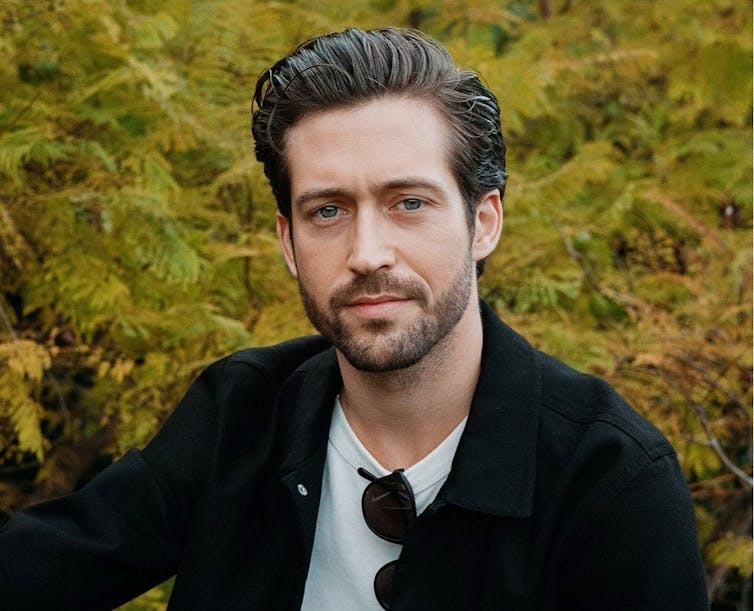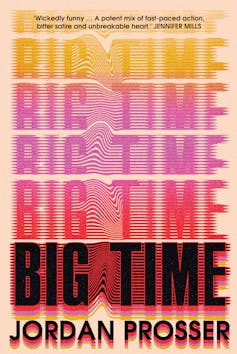
Jordan Prosser’s debut novel, Big Time, is a time-travelling, mind-bending love letter to art and creativity, set in a dystopian near future. It looks to the power of storytelling and asks: what difference can it possibly make?
In the autocratic Federal Republic of East Australia, music, science and political expression are policed with the threat of labour camps and execution. Julian Freeman is the bass player of The Acceptables, who were catapulted to stardom on the back of their breakout, inoffensive-pop first album, titled “Artificial Beaches on Every Mountain / Artificial Mountains on Every Beach”. He returns to Melbourne after a year abroad for the recording of their second.
On the flight home, he first encounters the drug “F”, which allows the user a glimpse into the future. Most people see short distances ahead, depending on their tolerance: hours, maybe days. But, our narrator tells us, “Rumour says, with enough F, you can see to the end of time.”
Review: Big Time – Jordan Prosser (UQP)
Once home, Julian reunites with the band and its entourage: Ash, the heartthrob lead singer and his girlfriend (and Julian’s ex) Oriana; lead guitarist Xander and his little brother, Pony, who dreams of taking Julian’s place; Tammy on drums, who everyone underestimates; Skinner the manager with a dodgy past; and Wesley, the music reviewer who’s telling us this story.

The recording of the new album and its subsequent tour don’t go so well. Ash has written a manifesto blatantly at odds with the state’s cultural regime and refuses to accept any input from the rest of the band. And an intoxicating mix of drugs, booze and all those little glimpses of the future see old grudges and simmering conflicts rise to the surface – threatening to ruin their gigs and put their very lives at risk.
Meanwhile, there’s the discovery of the Anomaly, the first of many Extreme Coincidences that sparks a series of increasingly bizarre chronological disturbances. Is time coming off the rails? Or is it all in our collective heads?
Art in interesting times
Ash is determined to make a difference with The Acceptables’ second album, titled “In the End It’s All Okay, and If It Ain’t Okay, It Ain’t the End”. He wants to take risks and stand for something, goaded on by Oriana, who has an agenda of her own. This puts him at odds with Julian, who just wants to play music and survive.
All three characters, at some point, come up against the same question: what role should art play in turbulent times?

The book itself seems preoccupied with this problem, asking in multiple ways whether artists, writers, musicians, and creators of all kinds owe the world anything. If people listen to you, do you have a duty to speak truth to power, no matter how dangerous that might be?
One of those ways is to constantly remind us this, too, is a story. We might find ourselves becoming immersed, but the narrator, structure and even the typesetting always remind us that, no, we are reading this. Not living it. Indeed, the book argues, everything we experience – the past, the present, the future – is stories too: “Some true, others embellished”. In the end, once we have finished this story, will we come out changed? And will we impart that change onto the world?
It reminds us of its status as constructed storytelling in another way too, by leveraging a particular kind of storytelling: science fiction.
Science fiction and imagining the future
When Julian returns home, Oriana realises he has a particularly high tolerance for F and can see much further than anyone else. While she doesn’t do the drug herself, Oriana has access to a prodigious supply. She is more than happy to distribute it, on the condition she can record what users see and how far into the future they go.
She wants to answer the question: are the visions F users see premonitions or hallucinations? After all, truth matters when you’re dealing with the future. What’s the point of visions you can’t trust?
This is a line science fiction walks too. The genre is not really trying to predict the future, but even the most escapist adventure in space is an imagining of a future. And our attitudes to those futures have an impact on the way we live in the present.
In Big Time, Julian and the drug F, along with Extreme Coincidence and the increasing social anxiety around time itself, provide a focal point to examine the relationship between the futures we imagine and the futures we believe we can create.
If we know the future – or, at least, have envisioned different versions of it – we can be mindful of the choices we make now. Maybe we can escape the kind of bleak reality Big Time shows us.
Or is this just what I see? As the narrator explains:
Skipping ahead on F is a markedly different experience for everybody. Some people see their future in first person. Others say they can see themselves in the room. Others say they can leave their own selves behind and explore the wider world, unmoored, a spectre in time.
Science fiction and F have this in common: my experience of this imagined future will be different to yours. Is it an Extreme Coincidence that my personal obsessions – science fiction and its role as a foresight tool – are so present in this book? Or, I might ask, am I influencing the experiment by observing it – creating patterns and making meanings that aren’t there for anyone else?
Ambitious and mind-boggling
Big Time is an ambitious project, weaving multiple narratives, thematic threads, points of view, and timeframes together with a heady dose of anarchic punk sensibility. At times, it feels like this scope overwhelms the story.
A mind-boggling array of characters with in-depth side stories and backstories can derail the momentum. This leaves the pacing in the final section feeling stymied. The prologue and epilogue attempt to bookend Julian’s story but, to my mind, come perilously close to running afoul of one of science fiction’s gravest sins. Which I would love to debate in further detail but … spoilers.
Ultimately, Big Time revels in the human drive to make art and forge connection even in the most oppressive situations – and it whisks us along for the ride. It’s a joyful, heartbreaking, chaotic and thought-provoking road trip through a future that feels more possible than we might like. A future that is ours to make.
Joanne Anderton does not work for, consult, own shares in or receive funding from any company or organisation that would benefit from this article, and has disclosed no relevant affiliations beyond their academic appointment.
This article was originally published on The Conversation. Read the original article.







